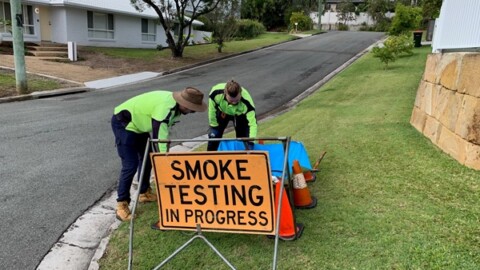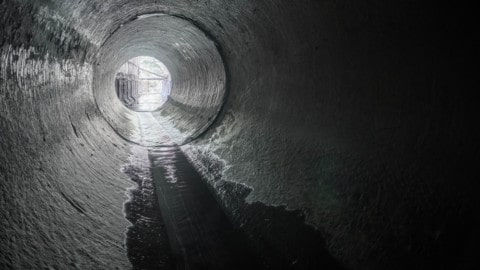By Eliza Booth, Assistant Editor, Pump Industry magazine
For towns and cities that rely on surface water sources, transmission losses can result in water supply issues, especially when inflows are low. This was a major problem for drought-hit Tamworth, in northeast New South Wales, where it resulted in almost double the town’s annual water demand to be lost. With the devastating drought threatening residents and businesses, WaterNSW is constructing a permanent pipeline and pumping infrastructure, which will provide a long-term solution to reduce losses and help Tamworth survive the drought.
Residents and businesses in the regional township of Tamworth have always relied primarily on surface water from the Chaffey Dam, which made its way to the Calala Water Treatment Plant via the Peel River.
The issue with relying on surface water supplies from the dam is that there can be large transmission losses as the water makes its way down the river, resulting in losses of up to 17,000ML per year, or almost double Tamworth’s annual water demand.
Without a viable groundwater source to supplement the town’s supply, and with deteriorating reliability of water due to the drought, WaterNSW decided to undertake drought protection works to limit the amount of transmission losses and to assist in extending vital water supply while a permanent, long-term pipeline solution is constructed.
A secure solution for Tamworth
It became clear to WaterNSW and Tamworth Regional Council that without drought protection works in place, and with the absence of significant rainfall, residents, businesses and landholders were at risk of running out of water by mid-2020.
“There have been unprecedented low inflows into Chaffey Dam which supplies water to the city of Tamworth. The Peel Drought Relief Project will ensure Tamworth does not run out of water should the severe drought conditions continue into 2020,” a spokesperson for WaterNSW said.
The spokesperson said the drought relief project includes two stages of works, incorporating both short and long-term infrastructure to secure water supply for current and future needs.
Stage 1 works were completed on 2 December 2019 and included the construction of a temporary weir on the Peel River at Dungowan.
“This weir will redirect river water via the existing Dungowan to Tamworth Water Pipeline for transportation to Tamworth City Council’s water treatment plant at Calala, reducing transmission losses the water would experience had it traveled the full distance of the Peel River into Tamworth,” the WaterNSW spokesperson said.

This stage of the project also included the construction of vital intake infrastructure to assist in diverting water to the Tamworth Water Treatment Plant.
This infrastructure will now remain in place while the long-term solution is being constructed in Stage 2 of the project.
Stage 2 of the drought protection works include the construction of a new 18.2km permanent (710mm) HDPE pipeline connecting Chaffey Dam to the existing Dungowan to Tamworth Water Pipeline.
“This will eliminate the significant losses along the Peel River due to evaporation and seepage, conserve the remaining storage in Chaffey Dam, and therefore prolong water supplies for the critical human needs of Tamworth,” the WaterNSW spokesperson said.
Selecting a contractor
Selecting a contractor is an important part of every project and it was essential that WaterNSW chose the right team who could achieve a successful outcome while also working in tight timeframes.
The spokesperson said WaterNSW engaged pipeline construction contractor MPC Kinetic to design, procure and build all elements of the Stage 1 and 2 project scopes.
“MPC Kinetic self-performed all pipeline design, construction and commissioning scopes, but went to the market for the Stage 1 Temporary and Stage 2 permanent pump station scopes,” the WaterNSW spokesperson said.
“These scopes included pump station construction, pump supply and all associated electrical and civil installations.”
When it came to equipment selection for the project, a spokesperson for MPC Kinetic said that the ability to meet the extremely tight timeframe the project demanded was a critical factor in choosing suppliers.
Constructing the weir and pump station
With the right contractor selected, Stage 1 works powered ahead, with the construction of the temporary weir and associated pumping and pipeline infrastructure quickly being constructed on the banks of the diminishing Peel River.
“The Stage 1 temporary works included construction of a temporary weir made of prefabricated concrete box culverts across the Peel River, the installation of three large temporary pumps, and construction of an above ground temporary 500m-long (500mm) HDPE pipeline to interconnect into the existing Dungowan to Tamworth Water Pipeline,” the WaterNSW spokesperson said.
“The temporary pump station was constructed on the banks of the Peel River next to the Dungowan Showgrounds alongside the temporary weir. It consisted of two 125L per second (10.8ML/day) main pumps and one 125L per second (10.8ML/d) backup pump.
All pumps had individual capacity to provide up to 12ML per day to ensure Tamworth received its required water supply of 21.6ML per day.”
The right pumps to handle demand
In order to ensure Tamworth would receive its required daily water supply while the permanent pipeline was being constructed, the temporary weir and accompanying pump station needed to be able to keep up with demand from the water treatment plant.
“The temporary Stage 1 works are required to deliver up to 21.6ML/d to the Calala Water Treatment Plant,” the WaterNSW spokesperson said.
“This is achieved by pumping into the existing Dungowan to Tamworth Water Pipeline which has a break tank at a high point prior to the water treatment plant, from which point supply gravitates to Calala.
“When the treatment plant calls for water, the water level in the break tank drops. Demand through the treatment plant varies from approximately 21.6ML/d to 10.4ML/d.
The Stage 1 pumps ramp up and down to maintain the water level in the break tank within a certain range, which requires them to operate with variable flow capability.”
In order to facilitate the need for variable flow capability, WaterNSW employed the use of three diesel engine pumps which have been programmed to ramp their speed up and down to match flow being called at the treatment plan.
The spokesperson said these pumps acted similar to pumps driven by variable speed motors, allowing the smooth flow of water into the treatment plant and onto the town.
Powering through Stage 2
With the Stage 1 temporary weir and pump station successfully completed and operating, Stage 2 of the project could begin. The spokesperson said that most of the construction for the long-term pipeline has been completed so far and is on track to be finished on time.
“MPC Kinetic has made significant progress on Stage 2. As of Thursday, March 5, 85 per cent of the pipeline has been constructed and buried,” the spokesperson said.
“Construction crews have also completed 65 per cent of the Stage 2 pump station scope and the entire project will be completed on schedule by April 2020.”
In the meantime, maintenance and operation of the temporary pump station remains a vital part of ensuring Tamworth remains well supplied with water.
“WaterNSW, the Tamworth City Council and construction contractor MPC Kinetic, are collaborating on the 24-hour operation of the temporary pump station, while Stage 2 project works are being progressed,” the WaterNSW spokesperson said.



















